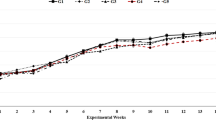Abstract
The tea catechin (−)-epigallocatechin-3-gallate (EGCG) inhibits cancer cell proliferation and induces apoptosis. Effects of EGCG on growth of immortalized intestinal and colon cancer cells and involvement of reactive oxygen species (ROS) were studied. Low concentrations of EGCG (<20 μM) stimulated cell growth (up to 60%) and high concentrations were inhibitory and induced apoptosis. H2O2 at concentrations similar to levels generated by low dosage EGCG (<5 μM) stimulated cell growth. Addition of SOD and catalase to EGCG-treated cells reduced these effects, suggesting a role for EGCG-produced ROS. EGCG produced H2O2 in a cell culture medium. Fetal bovine serum and bovine serum albumin reduced cell associated EGCG by 90% and decreased growth inhibitory effects and H2O2 generation from EGCG slightly. EGCG modulated intestinal cell growth either by induction of cell death or by growth stimulation via ROS generation in a culture medium.
Similar content being viewed by others
References
Lambert JD, Hong J, Yang GY, Liao J, Yang CS. Inhibition of carcinogenesis by polyphenols: Evidence from laboratory investigations. Am. J. Clin. Nutr. 81: 284S–291S (2005)
Yang CS, Hong J. Prevention of chronic diseases by tea: Possible mechanisms and human relevance. Annu. Rev. Nutr. 33: 161–181 (2013)
Hou Z, Lambert JD, Chin KV, Yang CS. Effects of tea polyphenols on signal transduction pathways related to cancer chemoprevention. Mutat. Res. 555: 3–19 (2004)
Yang CS, Sang S, Lambert JD, Hou Z, Ju J, Lu G. Possible mechanisms of the cancerpreventive activities of green tea. Mol. Nutr. Food Res. 50: 170–175 (2006)
Hou Z, Sang S, You H, Lee MJ, Hong J, Chin KV, Yang CS. Mechanism of action of (-)-epigallocatechin-3-gallate: Autooxidation-dependent inactivation of epidermal growth factor receptor and direct effects on growth inhibition in human esophageal cancer KYSE 150 cells. Cancer Res. 65: 8049–8056 (2005)
Lung HL, Ip WK, Chen ZY, Mak NK, Leung KN. Comparative study of the growth inhibitory and apoptosis-inducing activities of black tea theaflavins and green tea catechin on murine myeloid leukemia cells. Int. J. Mol. Med. 13: 465–471 (2004)
Gupta S, Hastak K, Afaq F, Ahmad N, Mukhtar H. Essential role of caspases in epigallocatechin-3-gallate-mediated inhibition of nuclear factor kappa B and induction of apoptosis. Oncogene 23: 2507–2522 (2004)
Shimizu M, Deguchi A, Joe AK, McKoy JF, Moriwaki H, Weinstein IB. EGCG inhibits activation of HER3 and expression of cyclooxygenase-2 in human colon cancer cells. J. Exp. Ther. Oncol. 5: 69–78 (2005)
Hong J, Kim M-R, Lee NH, Lee BH. Inhibition of oral epithelial cell growth in vitro by epigallocatechin-3-gallate: Its modulation by serum and antioxidant enzymes. Food Sci. Biotechnol. 18: 971–977 (2009)
Masuda M, Suzui M, Weinstein IB. Effects of epigallocatechin-3-gallate on growth, epidermal growth factor receptor signaling pathways, gene expression, and chemosensitivity in human head and neck squamous cell carcinoma cell lines. Clin. Cancer Res. 7: 4220–4229 (2001)
Shimizu M, Deguchi A, Lim JT, Moriwaki H, Kopelovich L, Weinstein IB. (-)-Epigallocatechin gallate and polyphenon E inhibit growth and activation of the epidermal growth factor receptor and human epidermal growth factor receptor-2 signaling pathways in human colon cancer cells. Clin. Cancer Res. 11: 2735–2746 (2005)
Dong Z. Effects of food factors on signal transduction pathways. Biofactors 12: 17–28 (2000)
Yang GY, Liao J, Li C, Chung J, Yurkow EJ, Ho CT, Yang CS. Effect of black and green tea polyphenols on c-jun phosphorylation and H2O2 production in transformed and nontransformed human bronchial cell lines: Possible mechanisms of cell growth inhibition and apoptosis induction. Carcinogenesis 21: 2035–2039 (2000)
Hong J, Lu H, Meng X, Ryu JH, Hara Y, Yang CS. Stability, cellular uptake, biotransformation, and efflux of tea polyphenol (-)-epigallocatechin-3-gallate in HT-29 human colon adenocarcinoma cells. Cancer Res. 62: 7241–7246 (2002)
Mochizuki M, Yamazaki S, Kano K, Ikeda T. Kinetic analysis and mechanistic aspects of autoxidation of catechins. Biochim. Biophys. Acta 1569: 35–44 (2002)
Kim HS, Quon MJ, Kim JA. New insights into the mechanisms of polyphenols beyond antioxidant properties; Lessons from the green tea polyphenol, epigallocatechin-3-gallate. Redox Biol. 2: 187–195 (2014)
Yang GY, Liao J, Kim K, Yurkow EJ, Yang CS. Inhibition of growth and induction of apoptosis in human cancer cell lines by tea polyphenols. Carcinogenesis 19: 611–616 (1998)
Vittal R, Selvanayagam ZE, Sun Y, Hong J, Liu F, Chin KV, Yang CS. Gene expression changes induced by green tea polyphenol (-)-epigallocatechin-3-gallate in human bronchial epithelial 21BES cells analyzed by DNA microarray. Mol. Cancer Ther. 3: 1091–1099 (2004)
Dvorakova K, Payne CM, Tome ME, Briehl MM, McClure T, Dorr RT. Induction of oxidative stress and apoptosis in myeloma cells by the aziridine-containing agent imexon. Biochem. Pharmacol. 60: 749–758 (2000)
Riedl KM, Hagerman AE. Tannin-protein complexes as radical scavengers and radical sinks. J. Agr. Food Chem. 49: 4917–4923 (2001)
Hatano T, Hori M, Hemingway RW, Yoshida T. Size exclusion chromatographic analysis of polyphenol-serum albumin complexes. Phytochemistry 63: 817–823 (2003)
Kusuda M, Hatano T, Yoshida T. Water-soluble complexes formed by natural polyphenols and bovine serum albumin: Evidence from gel electrophoresis. Biosci. Biotech. Bioch. 70: 152–160 (2006)
Papadopoulou A, Green RJ, Frazier RA. Interaction of flavonoids with bovine serum albumin: A fluorescence quenching study. J. Agr. Food Chem. 53: 158–163 (2005)
Nozaki A1, Hori M, Kimura T, Ito H, Hatano T. Interaction of polyphenols with proteins: Binding of (-)-epigallocatechin gallate to serum albumin, estimated by induced circular dichroism. Chem. Pharm. Bull. 57: 224–228 (2009)
Author information
Authors and Affiliations
Corresponding author
Rights and permissions
About this article
Cite this article
Kwon, S.J., Lambert, J.D., Yang, C.S. et al. Role of reactive oxygen species from the green tea catechin, (−)-epigallocatechin-3-gallate in growth modulation of intestinal cells. Food Sci Biotechnol 24, 1541–1548 (2015). https://doi.org/10.1007/s10068-015-0198-5
Received:
Revised:
Accepted:
Published:
Issue Date:
DOI: https://doi.org/10.1007/s10068-015-0198-5




